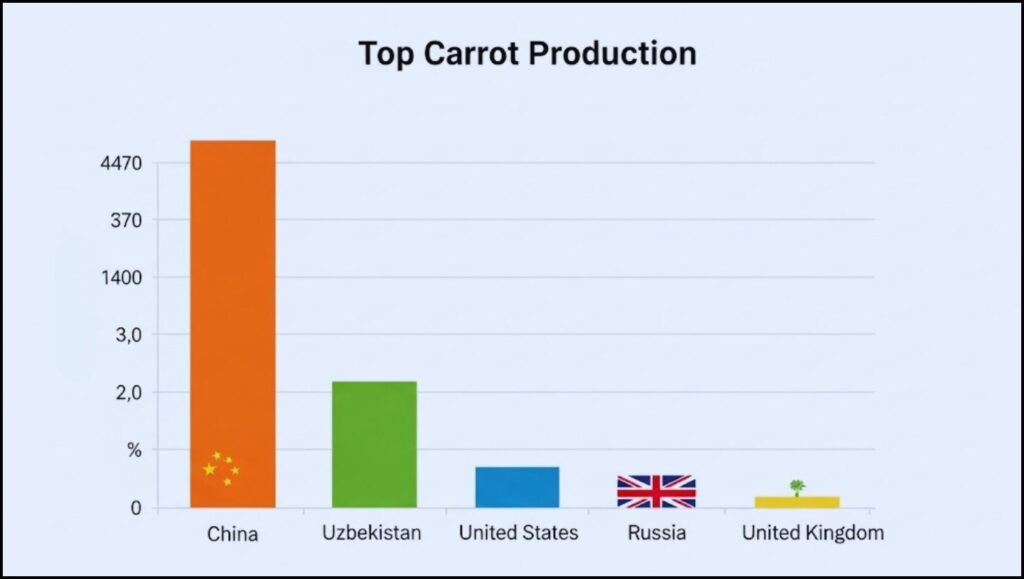China stands as the definitive World’s Largest Carrot Producer, an agricultural powerhouse that accounts for a substantial portion of the world’s supply of this ubiquitous root vegetable. With an output far surpassing any other country, its dominance in the market is the result of a combination of vast cultivated land, advanced farming technologies, and a strategic approach to both domestic consumption and international exports. This preeminence has made the country a linchpin in the global food supply chain for carrots and related products.

China’s Unparalleled Scale and Production Efficiency
According to recent data from sources like the Food and Agriculture Organization (FAO) of the United Nations, China’s annual production of carrots and turnips is estimated to be over 20 million metric tons, representing more than 40% of the total global output. This remarkable figure is not merely a reflection of the country’s size but of its highly organized and technologically driven agricultural sector. The nation’s carrot farming is concentrated in several key provinces, including Shandong, Hebei, and Inner Mongolia, each with staggered growing seasons that enable year-round harvesting.
“The sheer volume and consistency of China’s carrot output are unmatched globally,” said Dr. Anya Sharma, an agricultural economist specializing in international food systems. “Their ability to produce high-quality carrots year-round gives them a significant competitive advantage in the export market, allowing them to meet consistent demand from importers across Asia, the Middle East, and beyond.”
This year-round supply is made possible by the diverse climates and soil conditions across China’s major agricultural regions. For example, carrots are harvested in the southern province of Fujian from January to April, followed by a season in Shandong from May to June, and then by harvests in Hebei and Inner Mongolia later in the year. This geographical and logistical coordination ensures a continuous flow of the vegetable to markets.

Economic Drivers and Export Dominance
The economic importance of the carrot industry in China extends beyond domestic consumption. The country is also a major exporter, with its products reaching markets worldwide. Chinese carrots are exported to neighboring Asian countries, as well as to markets in the Middle East and parts of Europe, according to trade data. This export strength is underpinned by competitive pricing, which is a direct result of lower production costs and economies of scale.
The nation’s carrot industry is not solely focused on fresh produce. A significant portion of the harvest is directed toward processing, including the production of carrot juice, canned carrots, and frozen products. This diversified approach adds value to the crop and helps to minimize waste, strengthening the overall economic viability of the sector. The domestic market for carrots is also robust, as the vegetable is a staple ingredient in a wide variety of Chinese culinary traditions, from stir-fries to pickled dishes.
Challenges and Innovations in a Changing Climate
Despite its dominant position, China’s carrot production faces modern challenges. Like all agricultural sectors, it is increasingly vulnerable to the effects of climate change, including shifts in weather patterns, prolonged droughts, and extreme temperatures. These abiotic stressors can impact crop yield and quality, posing a threat to both domestic and international supplies.
In response, Chinese farmers and agricultural researchers are implementing a number of innovative strategies. The use of advanced irrigation systems, high-yield and disease-resistant seed varieties, and integrated pest management (IPM) programs have become more common. Genetic engineering and selective breeding are also being used to develop new carrot varieties that are more resilient to heat, salinity, and specific diseases like black rot and cavity spot.
The government has also played a role in promoting sustainable practices and technological adoption. Through various agricultural support programs, officials are working to ensure that the nation’s food security remains robust while also maintaining its position as a leading global agricultural exporter.
The global carrot market is characterized by a few key players, but none possess the scale of China’s production. While countries like Uzbekistan and the United States are also significant producers, their output is a fraction of China’s. Uzbekistan, for instance, ranks second but produces a little over a quarter of China’s volume. The United States, a major consumer of carrots, produces even less and relies on imports to meet domestic demand. Ultimately, the story of global carrot production is a testament to the power of a country’s focused agricultural policy and investment in technology. As climate and market conditions continue to evolve, China’s ability to adapt and innovate will be crucial not only for its own food security but for the stability of a key global commodity.
Indonesia Cements Lead as World’s Largest Coconut Oil Producer, Outpacing Philippines
